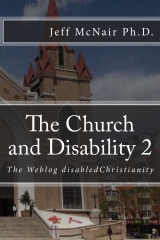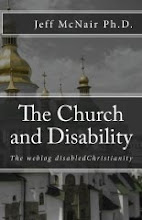When disability experts try to explain what disability is, they may use two models of disability: the medical model and the social model.
The medical model tends to see disability as a characteristic of an individual. So those in special education, or rehabilitation or other fields, including medicine, see a characteristic of an individual and attempt to improve the person's life who has that characteristic. In special education, for example, innovative methods for teaching reading have been developed to maximize a student's reading ability who might have difficulty learning to read. There is nothing wrong with these kinds of approaches. The problem sometimes comes when disability is seen as exclusively a characteristic of individuals.
The social model basically says that disability is discrimination. That is, I have a characteristic called impairment (whether physical, intellectual, etc.) and because of that characteristic, I am treated with discrimination by the social environment.
In thinking about how to address disability via interventions of one sort or another, it seems that human services (education, social work, rehabilitation, etc.) tend to focus almost exclusively on medical model strategies. They work to improve my skills, or my health or other things related to me personally. It is rare if at all that there are social model interventions undertaken. Let's think that through for a minute.
Imagine we have two individuals. One is the a person who is living in society, but they have no religious interest or are not participating in any kind of religious group. The other person is someone who has a religious interest and does participate in a Christian church of some flavor. How would one attempt to develop social model interventions aimed at diminishing discrimination in each person's social group?
For the individual who does not participate in a religious group, this becomes somewhat difficult. First of all, in which social settings would they find some form of integration? These are limited at best. If I were to attempt some form of intervention to reduce discrimination, it would have to be with the larger community, or city or even state or nation. It is no wonder that these types of interventions are rarely undertaken by human service providers. They are hugely daunting. It may actually be that human services are so medical model based that there is little effort to first of all even work toward community integration or understand what it is (visit this article for more on this), and second address social model issues. So there is probably less awareness over discrimination related to clients being in the community.
For the individual who does participate in a religious group, a Christian church, the foci for intervention is much more easily determined. If the church is comprised of 1000 members, for example, I can work within that social setting to mitigate discrimination which might be occurring. I can talk with leaders of the group, trying to help them to understand the discrimination that persons with impairments experience, give them strategies to reduce that on just a logical basis, or on the basis of the scriptures they state as underlying their religious practices. In other words, there are many options I might follow to work to reduce discrimination. I have worked doing these types of interventions with some degree of success.
I think the take home lesson of this is first that social model interventions are not occurring because human service providers envision a life for persons with disabilities that apparently does not include community integration based only on observable interventions they engage in. Second, religious/church involvement puts the possibility of social model interventions on the table in an easily employed manner.
Those in human services should seek the opportunity for church involvement for those they serve for a variety of reasons. But one of the most important is the ability to develop and implement social model interventions which would lead to community integration and attenuated discrimination toward those with impairments.
McNair
The medical model tends to see disability as a characteristic of an individual. So those in special education, or rehabilitation or other fields, including medicine, see a characteristic of an individual and attempt to improve the person's life who has that characteristic. In special education, for example, innovative methods for teaching reading have been developed to maximize a student's reading ability who might have difficulty learning to read. There is nothing wrong with these kinds of approaches. The problem sometimes comes when disability is seen as exclusively a characteristic of individuals.
The social model basically says that disability is discrimination. That is, I have a characteristic called impairment (whether physical, intellectual, etc.) and because of that characteristic, I am treated with discrimination by the social environment.
In thinking about how to address disability via interventions of one sort or another, it seems that human services (education, social work, rehabilitation, etc.) tend to focus almost exclusively on medical model strategies. They work to improve my skills, or my health or other things related to me personally. It is rare if at all that there are social model interventions undertaken. Let's think that through for a minute.
Imagine we have two individuals. One is the a person who is living in society, but they have no religious interest or are not participating in any kind of religious group. The other person is someone who has a religious interest and does participate in a Christian church of some flavor. How would one attempt to develop social model interventions aimed at diminishing discrimination in each person's social group?
For the individual who does not participate in a religious group, this becomes somewhat difficult. First of all, in which social settings would they find some form of integration? These are limited at best. If I were to attempt some form of intervention to reduce discrimination, it would have to be with the larger community, or city or even state or nation. It is no wonder that these types of interventions are rarely undertaken by human service providers. They are hugely daunting. It may actually be that human services are so medical model based that there is little effort to first of all even work toward community integration or understand what it is (visit this article for more on this), and second address social model issues. So there is probably less awareness over discrimination related to clients being in the community.
For the individual who does participate in a religious group, a Christian church, the foci for intervention is much more easily determined. If the church is comprised of 1000 members, for example, I can work within that social setting to mitigate discrimination which might be occurring. I can talk with leaders of the group, trying to help them to understand the discrimination that persons with impairments experience, give them strategies to reduce that on just a logical basis, or on the basis of the scriptures they state as underlying their religious practices. In other words, there are many options I might follow to work to reduce discrimination. I have worked doing these types of interventions with some degree of success.
I think the take home lesson of this is first that social model interventions are not occurring because human service providers envision a life for persons with disabilities that apparently does not include community integration based only on observable interventions they engage in. Second, religious/church involvement puts the possibility of social model interventions on the table in an easily employed manner.
Those in human services should seek the opportunity for church involvement for those they serve for a variety of reasons. But one of the most important is the ability to develop and implement social model interventions which would lead to community integration and attenuated discrimination toward those with impairments.
McNair










